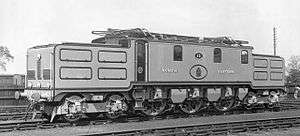LNER Class EE1
 | |||||||||||||||||||||||
| |||||||||||||||||||||||
| |||||||||||||||||||||||
| |||||||||||||||||||||||
| |||||||||||||||||||||||
British Rail Class EE1 (Electric Express 1)[1] was an electric locomotive commissioned by the North Eastern Railway in 1922. Ownership passed to the London and North Eastern Railway in 1923 and to British Railways in 1948.
It was an electrically powered locomotive in the pre-TOPS period.
Overview
In the 1910s the North Eastern Railway made plans to electrify its York-Newcastle main line and this locomotive was built for hauling passenger trains. It had an electrically-heated boiler to generate steam for train heating.
The wheels were arranged as in a 4-6-4 steam locomotive and the driving wheels were 6 ft 8 in (2.032 m) diameter. Each of the three driving axles was powered by a pair of traction motors. Electric locomotives of this design were common in continental Europe and the United States, but this was the only example on a British railway.
After grouping in 1923 the London and North Eastern Railway dropped the electrification project so (apart from some trials on the Shildon line) the locomotive was never used.[1] It survived into British Railways ownership but was withdrawn in August 1950, and scrapped on 15 December 1950.[1]
In common with other LNER electric locomotives, no classification was given to this locomotive until 4 October 1945, when no. 13 was classified EE1 (Electric Express 1).[1] In May 1946, no. 13 was renumbered to 6999; and under British Railways, it became no. 26600 in 1948.[1][2]
Specification
- Numbers: (NER) 13; (LNER) 6999; (BR) 26600
- Wheel arrangement: 2-Co-2
- Introduced: 1922
- Builder: North Eastern Railway
- Motors: 6 x 300 hp (220 kW), Metropolitan-Vickers
- Total power: 1,800 hp (1,342 kW)
- Supply: 1,500 V DC overhead
Notes
- 1 2 3 4 5 Boddy et al. 1990, p. 98.
- ↑ Boddy et al. 1990, fig. 134.
References
- Hoole, K. (1988). The Electric Locomotives of the North Eastern Railway. Headington: Oakwood Press. ISBN 0-85361-367-2. Locomotion Papers LP167.
- Boddy, M.G.; Fry, E.V.; Hennigan, W.; Hoole, Ken; Mallaband, Peter; Neve, E.; Price, J.H.; Proud, P.; Yeadon, W.B. (April 1990). Fry, E.V., ed. Locomotives of the L.N.E.R., part 10B: Railcars and Electric Stock. Lincoln: RCTS. ISBN 0-901115-66-5.
- The NER Electric 2-Co-2 Class EE1 Locomotive No. 13